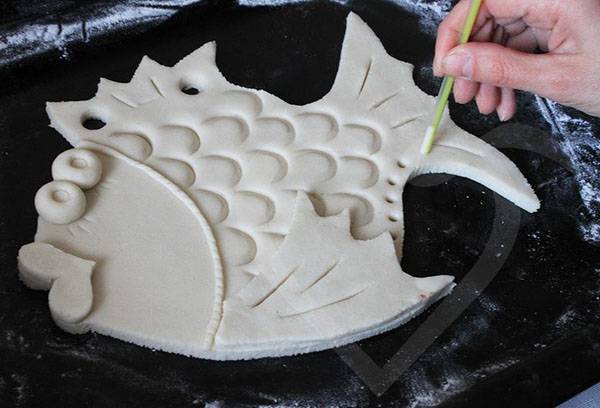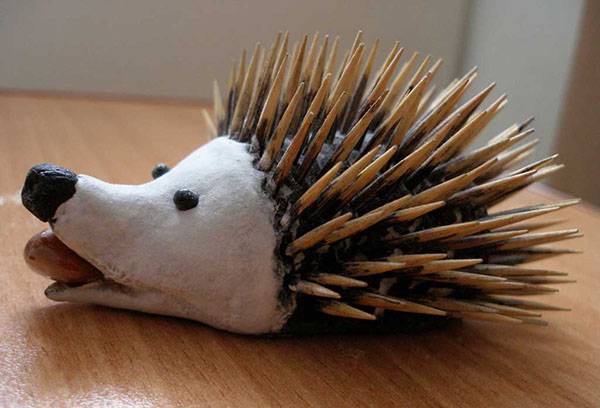Methods for drying salt dough, the pros and cons of each of them
If you have to dry a craft for the first time, it will be useful to learn some subtleties. First of all, you need to understand the difference between drying and baking. It is a mistaken belief that an oven – electric or gas – is only suitable for baking. You can also dry the dough in it. It is important to know how and for how long.

There are several ways to dry salt dough:
- in the sun;
- at room temperature;
- on battery;
- in the oven;
- in the microwave;
- in a combined way.
Each of them has its own advantages and disadvantages.
| Type of drying | pros | Minuses |
|---|---|---|
| In the sun | Does not require energy consumption | The craft takes a long time to dry |
| At room temperature | Economical | It takes a long time to dry. Indentations will remain on the product in contact with any surface. |
| On battery | Convenient to use in winter when the batteries are warm | The area does not allow drying volumetric figures |
| In the oven | The fastest way | Difficult to calculate temperature |
| In the microwave | Microwave cannot be used! | |
| Combined method | Suitable for drying large crafts | Labour intensive |
How long will it take to dry the craft?
Let's take a closer look at how long it will take a dough product to dry in one way or another.
- In the sun or in the room. The most economical method, as it does not require gas or electricity consumption. But with this method, every millimeter of the craft will take 24 hours to dry. This will happen much faster in the sun. This option is not suitable for large figures.
- In an electric oven. Time is calculated using the formula - 1 hour for every half centimeter of product thickness at a temperature of 75 degrees. Place the figurine in a cold oven. The temperature is increased every hour by 25 degrees.
- In a gas oven. Here, dough products dry twice as fast. Dry over low heat with the door slightly open. The first hour it is opened halfway, the second hour - a quarter, the third - the door is closed.
- Combined method. For two days, the craft is kept in the air, then sent to the oven for an hour, heated to 50 degrees, gradually increasing the temperature to a maximum of 150. This method is good for large products.
- On the battery (radiator). First cover the radiator with foil or cloth. It is better to place a board or plywood so that the ribbed surface of the battery does not deform the molding. Keep until completely dry.
- It is not recommended to dry salt dough in the microwave, since drying requires a very long time, which is not provided for in the software.
- Drying on the grill. An effective method, since everything will dry evenly. Electricity consumption is relatively low.
Advice
Drying will be more effective if done in several stages. Dry in the oven for an hour on one side, 24 hours at room temperature, the next day dry on the other side in the oven for an hour and a half.
What should I do to prevent the product from swelling or cracking?
Bloating, cracks, brittleness. A carefully sculpted figurine can easily be ruined. Therefore, it is important to know a few secrets.
- The salt dough should be dried either on a light baking sheet, or take into account the stronger heating of a dark baking sheet. In this case, the temperature must be reduced by 25 degrees.
- Hot products are very brittle. They should either be cooled on a baking sheet or removed with a spatula very carefully.
- The figures should not be raw. Readiness is checked in the old-fashioned way - you need to carefully tap the product with your finger. If the sound is ringing, the craft is ready; if it is dull, it needs to be dried.
- An under-dried craft will soon begin to deteriorate, change color and crack.
- To avoid bubbles, it is recommended to start drying with the oven door open.
- Before starting drying, the oven is heated to a minimum, they begin to dry on the top shelf, after the product is browned, it is placed on the middle one.
- The appearance of bubbles and swelling is a sign that the temperature must be lowered immediately, otherwise cracks will appear.
- Bubbles cannot be removed from the figure, but cracks can be carefully covered with PVA glue.
- Figures made from colored dough should be dried at a temperature no higher than 125 degrees so that the color does not change.
- The oven cannot be heated to more than 125 degrees if the craft is to be white. For the browning effect, the oven is heated to 200 degrees.
- After drying and painting, finished crafts are varnished to protect them from moisture.
Advice
The cause of cracking may be flour chosen incorrectly. It should not contain additives. You can add rye flour or 2 tbsp to the wheat flour. spoons of starch. The plasticity of the modeling dough is given by PVA glue (a tablespoon per glass of flour).
Products made from salt dough are one of the most accessible types of creativity. Sculpt with your children, dry correctly, and most importantly, as much as necessary. Enjoy the process!



My granddaughter had a class in kindergarten where they sculpted with salt dough. She liked it that way. So we sculpt with her all summer almost every day. And they didn’t even know how to dry it properly.